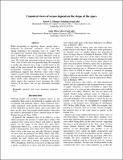Canonical views of scenes depend on the shape of the space
Author(s)
Ehinger, Krista A.; Oliva, Aude
DownloadOliva-CanonicalScene-CogSci2011.pdf (1.570Mb)
OPEN_ACCESS_POLICY
Open Access Policy
Creative Commons Attribution-Noncommercial-Share Alike
Terms of use
Metadata
Show full item recordAbstract
When recognizing or depicting objects, people show a preference for particular “canonical” views. Are there
similar preferences for particular views of scenes? We investigated this question using panoramic images, which
show a 360-degree view of a location. Observers used an interactive viewer to explore the scene and select the best view. We found that agreement between observers on the “best” view of each scene was generally high. We attempted to predict the selected views using a model based on the shape of the space around the camera location and on the navigational constraints of the scene. The model performance suggests that observers select views which capture as much of the surrounding space as possible, but do not consider navigational constraints when selecting views. These results seem analogous to findings with objects, which suggest that canonical views maximize the visible surfaces of an object, but are not necessarily functional views.
Date issued
2011-07Department
Massachusetts Institute of Technology. Department of Brain and Cognitive SciencesJournal
Proceedings of the 33rd Annual Cognitive Science Conference, COGSCI 2011, Boston, Massachusetts, Wednesday, July 20 - Saturday July 23, 2011
Publisher
Cognitive Science Society, Inc.
Citation
Ehinger, Krista A. and Aude Oliva. "Canonical views of scenes depend on the shape of the space." in Proceedings of the 33rd Annual Cognitive Science Conference, COGSCI 2011, July 20-23, 2011,Boston, Massachusetts USA.
Version: Author's final manuscript
ISBN
978-0-9768318-7-7